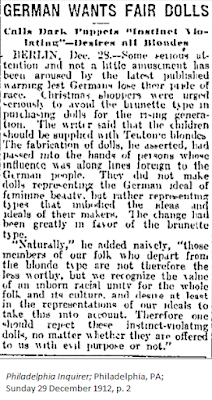© Kathy Duncan, 2022
I have spent the last couple of years reading period articles about doll manufacturing processes and factory conditions as well as the vocabulary associated with dolls. Occasionally, articles surface that reveal instances when dolls have been used in what we now call culture wars. I have hesitated to post the negative side of doll history, but I think that ultimately we can still enjoy our antique dolls while knowing that they were sometimes used for a nefarious political agenda. It is not too extreme to say that dolls have been weaponized in some instances.
During the Christmas season of 1912, newspapers across the United States ran an article expressing bemusement over what was viewed as an odd statement coming from a German official. From our 21st-century point of view, the message is bone-chilling, and the idea that brunette dolls were sold to Germans for evil purposes is just beyond comprehension. This is a copy from the Philadelphia Inquirer of 29 December 1912, but it is the exact same text that was duplicated by other papers:
Transcript:
"German Wants Fair Dolls
Calls Dark Puppets 'Instinct Violating' - Desires all Blondes
BERLIN, Dec. 28 - Some serious attention and not a little amusement has been argued by the latest published warning lest Germans lose their pride of race. Christmas shoppers were urged seriously to avoid the brunette type in purchasing dolls for the rising generation. The writer said that the children should be supplied with Teutonic blondes. The fabrication of dolls, he asserted, had passed into the hands of persons whose influence was along lines foreign to the German people. They did not make dolls respecting the German ideal of feminine beauty, but rather representing types that embodied the ideas and ideals of the makers. The change had been greatly in favor of the brunette type.
'Naturally,' he added naively, 'those members of our folk who depart from the blonde type are not therefore the less worthy, but we recognize the value of an inborn racial unity for the whole folk and its culture, and desire at least in the representations of our ideals to take this into account. Therefore one should reject these instinct-violating dolls, no matter whether they are offered to us with evil purpose or not.'"
The direct audience for this piece is the German shopper, with the primary message being to buy only blonde dolls. The subtext is that parents should not allow their children to have anything but blonde dolls or risk being guilty of lacking "pride of race." The indirect audience is the German doll maker, with the primary message being to manufacture only blonde dolls. The subtext is that manufacturers who produce brunette dolls are guilty of offering something evil to little German children and will shortly be deemed "less worthy."
While blonde dolls represented the official German ideal, the government official who made these statements either knew nothing of the manufacturing process of their dolls or chose to ignore the most ironic aspect. Those golden blonde tresses that were so highly valued did not begin that way. Just a year before, a U.S. newspaper reported the process that Germans used to make blonde doll wigs. They were importing human hair from China, extracting the natural color, and dying it blonde!
A small portion of an article entitled, "Christmas Dolls," published in the Stamford, Connecticut Daily Advocate on 14 December 1911, related the German's wig making process:

